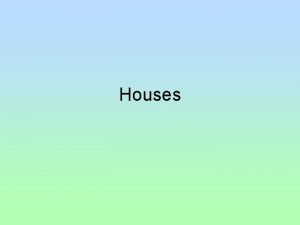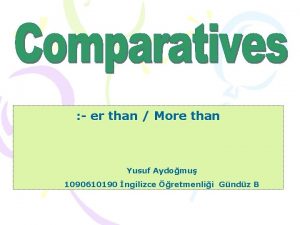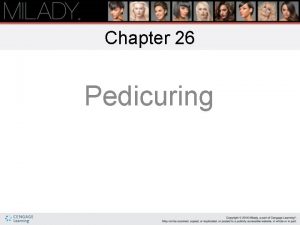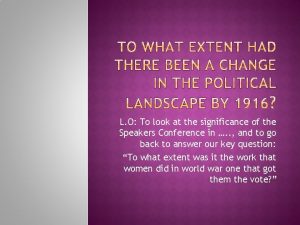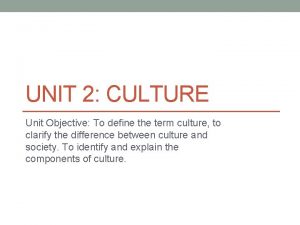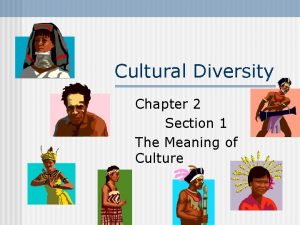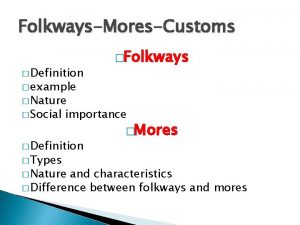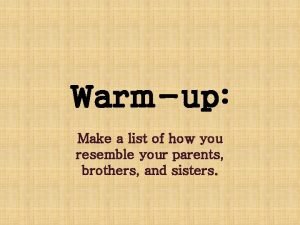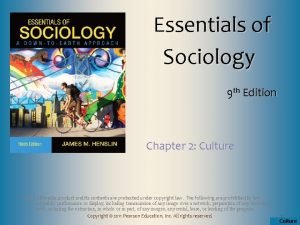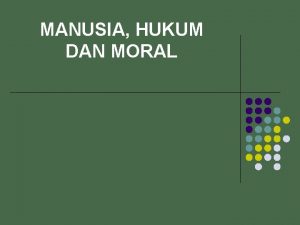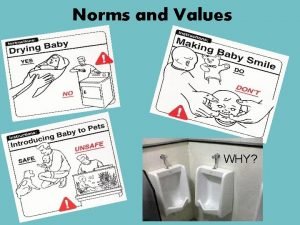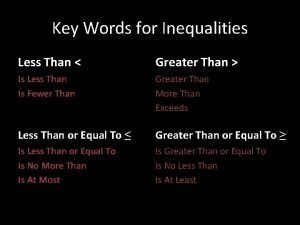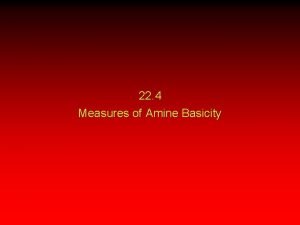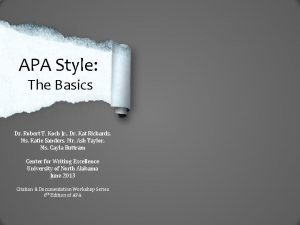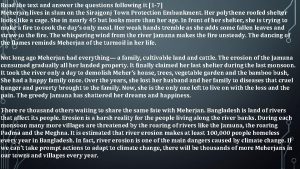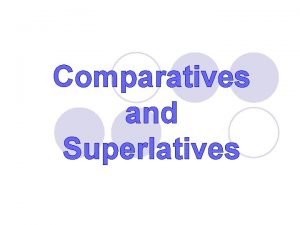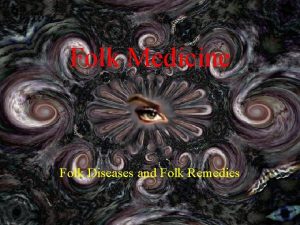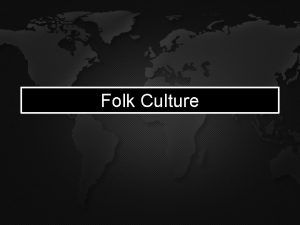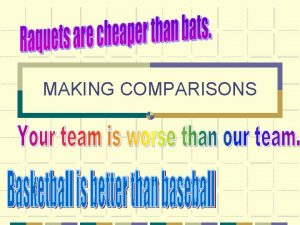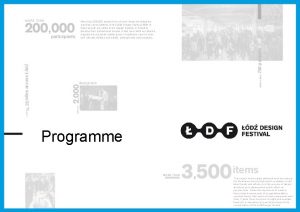Houses Folk ecology Folkways involve more than merely


























































- Slides: 58

Houses

Folk ecology • Folkways involve more than merely cultural adaptation – They are not enslaved and wholly shaped by their physical surroundings – Not necessarily true that they live in close harmony with their environment • Often soil erosion, deforestation, and overkill of wild animals can be attributed to traditional rural folk

Folk landscapes • Folk architecture most visible aspect of the landscape – Folk buildings are extensions of a people and their region – Provide the unique character of each district or province


Folk Architecture: Maasai House, Kenya • The Maasai are pastoralists who bring their cattle into their circular housing compounds at night. • Latticed frames are constructed with termite, ant and beetle resistant wood poles, insulated with packed leaves, and covered with cattle dung

Folk Architecture: Maasai House, Kenya • A snail-shell entry inhibits entry of human or animal intruders. • There are no windows, only vents for the central fire. • Insect damage and leakage call for ongoing maintenance. • Using plastic sheeting as a roof cover is a modern luxury few can afford.

Folk landscapes • Seek in folk architecture the traditional, the conservative, and the functional • Harmony with the physical environment – A visible expression of folk culture

Building materials • One way we classify folk houses and farmsteads is by the type of building materials used

Building materials • Environmental conditions influence choice of construction materials – Climate – Vegetation – Geomorphology • Shifting cultivators of tropical rain forests build houses of poles and leaves

Building materials • Sedentary subsistence farming peoples of adjacent highlands, oases, and river valleys of the Old World zone – Rely principally on earthen construction – Sun-dried (adobe) bricks – Pounded earth – In more prosperous regions, kiln-baked bricks are available

Building Materials • People in the tropical grasslands, especially in Africa, construct thatched houses from coarse grasses and thorn bushes

Building materials • Buildings of Mediterranean farmers and some rural residents of interior Indian and the Andean highlands – Most live in rocky, deforested lands – Use stone as principal building material – Create entire landscapes of stone • Walls, roofs, terraces, streets, and fences • Lends an air of permanence to the landscape

Folk architecture: China • The Kazak practice transhumance, spending the summer with their horses, goats, sheep and cattle in high pastures of the Tien Shan (Heavenly Mountains) of northwestern China. • These yurts have wooden trellis walls and are covered with felt which is pressed animal hair.

Folk architecture: China • The top flap can be opened to vent a central fire or closed to keep out rain. • As winter approaches, the yurt is dismantled and carried by pack animals to lower elevations.

Folk architecture: China • Many Kazak now winter in Chinese style, mud-brick, sodroofed houses. • Yurts are experiencing technological change as wood gives way to plastic and felt to canvas.

Building materials • Housing in the middle and higher latitudes – Houses made of wood where timber is abundant – In the United States, log cabins and later frame houses – Folk houses of northern Europe and in the mountains of eastern Australia are made of wood



Building materials • Housing in the middle and higher latitudes – In some deforested regions — Central Europe and parts of China • Farmers built half-timbered houses • Framework of hardwood beams with fill in the interstices of some other material – Sod or turf houses typify prairie and tundra areas • Russian steppes • In pioneer times, the American Great Plains – Nomadic herders often live in portable tents made of skins or wool


Floor plan • Unit farmstead – Single structure where family, farm animals, and storage facilities share space – In simplest form is one storied — People and animals occupy different ends of structure – More complex ones are multi-storied arranged so people and livestock live on different levels



Floor plan • Communal unit housing common among some shifting cultivators – Multiple families live under the same roof – Sleeping and cooking done in separate alcoves – Living space is shared

Floor plan • Communal unit housing common among some shifting cultivators – Example — the Sarawak longhouse found on the Malaysian portion of the island of Borneo • • Accommodates between 5 and 8 nuclear families An elongated dwelling Raised above forest floor on stilts Reflect a clan or tribal social organization

Borneo

Folk Architecture: Manali, India • The substantial stone roof will support a heavy winter snowfall. • Fodder and cattle are kept below the living quarters.

Floor plan • Most common are farmsteads where the house, barn, and stalls occupy separate buildings • Example of the courtyard farmstead – Various structures clustered around an enclosed yard – Appears in several seemingly unrelated culture regions – Found in Inca-settled portions of Andes Mountains – Also found in the hills of central Germany, and eastern China – Have wide distribution — offer privacy and protection


Irish folk houses • Other characteristics that help classify farmsteads and dwellings – Form or shape of roof – Placement of chimney – Details such as number and location of doors and windows • Estyn Evens – Used roof form and chimney placement, among other traits, in classifying Irish houses – Determined three major folk-housing culture regions


Folk housing in North America • Few folk houses are being built today • Popular culture with its mass-produced, commercially built houses has overwhelmed folk traditions • Many folk houses survive in refuge regions



Folk housing in North America • Yankee or New England folk houses – – Wooden frame construction Shingle siding often covers exterior walls Have a variety of floor plans New England large house — huge two-and-a-half stories, built around a central chimney and two rooms deep – As Yankee folk moved west, they developed the upright and wing dwelling – Houses are often massive because of cold winters


Folk housing in North America • Upland Southern folk houses – Smaller and built of notched logs—colonial Scandinavian settler technique – Saddlebag house--two log rooms separated by a double fireplace

The Mississippi Delta • The Shotgun House – Simple, Inexpensive, Efficient – Narrow Gable Front – Three or Four Rooms


Dogtrot House



Folk housing in North America • Upland Southern folk houses – Creole cottage-half-timbered with a central chimney and built-in porch, found in Acadiana, a French-derived folk region in Louisiana



Folk housing in North America • Canadian folk houses – House type found in French speaking Quebec • Main story atop a cellar, attic rooms beneath a curved, bell-shaped roof • Balcony-porch with railing extends across the front, which is sheltered by overhanging eaves • Summer kitchen sealed off during the long cold winters • Houses often built of stone


Folk housing in North America • Ontario farmhouse—occurs frequently in the Upper Canadian folk region – One-and-a-half stories tall, usually built of brick – Has distinctive gabled front dormer window

Southern New England • Heavily Framed Houses – Sturdy Posts, Stout Horizontal Beams – Simple Joinery, Overlapping Clapboards • Steep Roofs • Massive Central Chimneys


The Middle Atlantic Hearths Ethnically Diverse • Log Cabin Originated Here • I-House – Two-Story, One Room Deep – Two Rooms on each Floor

Southern Hearths • Southern Tidewater • The Mississippi Delta – Climate – Ethnic Mix

The Southern Tidewater • Coastal South Carolina & Georgia • Heat, Humidity, Flooding • Malaria, Mosquitoes, Extreme Heat • Charleston House – Single Row of Three or Four Rooms – Long Outside Veranda

WESTERN HEARTHS 1. Thick-Walled Spanish Adobe House 1. Long, Single Story 2. Flat or Low Pitched Roof 3. More Pueblo Indian than Spanish 2. Central-Hall Mormon House 1. Like an I House 2. Like a 4 over 4

Urban Adobe Houses Santa Fe, New Mexico



 More more more i want more more more more we praise you
More more more i want more more more more we praise you More more more i want more more more more we praise you
More more more i want more more more more we praise you R v millard and vernon
R v millard and vernon Meaning of acceptance house
Meaning of acceptance house Folk houses
Folk houses Er than more than
Er than more than 5730x5
5730x5 Greater than god more evil than the devil
Greater than god more evil than the devil Merely
Merely Vision without action is merely a dream
Vision without action is merely a dream Peace is not merely a distant goal
Peace is not merely a distant goal Pedicure toe separators target
Pedicure toe separators target Merely
Merely Merely
Merely Merely
Merely Merely
Merely Ya aburnee arabic
Ya aburnee arabic Folkways norms examples
Folkways norms examples Folkways taboos mores
Folkways taboos mores Folkways
Folkways Mores meaning in culture
Mores meaning in culture Importance of folkways
Importance of folkways The mysterious fall of the nacirema
The mysterious fall of the nacirema Nature of culture
Nature of culture Folkways taboos mores
Folkways taboos mores Ciri-ciri mores
Ciri-ciri mores Examples of informational social influence
Examples of informational social influence Compound inequality examples
Compound inequality examples Percent greater than 100 and less than 1
Percent greater than 100 and less than 1 Which is correct
Which is correct Fractions greater less than or equal to
Fractions greater less than or equal to Your love is deeper than the ocean higher than the heavens
Your love is deeper than the ocean higher than the heavens Numberblocks
Numberblocks Less than key words
Less than key words In text citation 3 authors example
In text citation 3 authors example Nobody in the world sells more real estate than remax
Nobody in the world sells more real estate than remax Basicity of arylamines
Basicity of arylamines Recognizing parallel structure
Recognizing parallel structure A medical school claims that more than 28
A medical school claims that more than 28 More than one author apa
More than one author apa Beneath this mask
Beneath this mask Is man no more than this
Is man no more than this Alt higher than ast
Alt higher than ast A dollar today is worth more than a dollar tomorrow
A dollar today is worth more than a dollar tomorrow Why are related forms more agreeable than unrelated forms
Why are related forms more agreeable than unrelated forms Thousands of possibilities get yours slogan
Thousands of possibilities get yours slogan Nothing is more precious than happiness and health
Nothing is more precious than happiness and health Why does new guinea have more species of birds than bali?
Why does new guinea have more species of birds than bali? Meherjan passage
Meherjan passage My love's more ponderous than my tongue
My love's more ponderous than my tongue Which equation represents sublimation?
Which equation represents sublimation? Paper has more patience than people. elucidate
Paper has more patience than people. elucidate Cfg are more powerful than
Cfg are more powerful than Two syllable words comparative
Two syllable words comparative Typologies are typically nominal composite measures.
Typologies are typically nominal composite measures. Is oil more dense than water
Is oil more dense than water Marketing more than any other business function deals with
Marketing more than any other business function deals with Metal and non metal example
Metal and non metal example Marketing more than any other business function deals with
Marketing more than any other business function deals with




